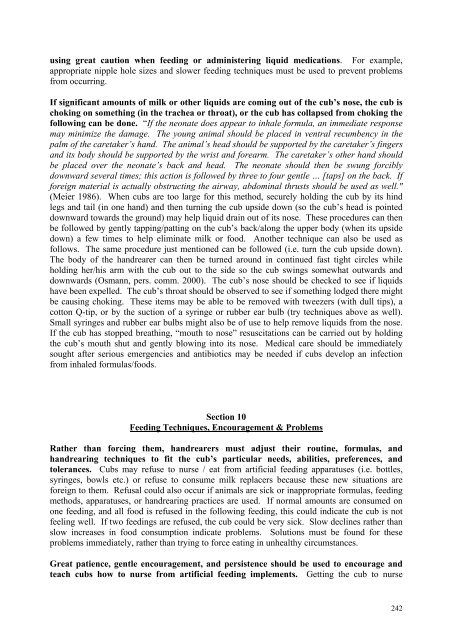International Giant Otter Studbook Husbandry and Management
International Giant Otter Studbook Husbandry and Management
International Giant Otter Studbook Husbandry and Management
You also want an ePaper? Increase the reach of your titles
YUMPU automatically turns print PDFs into web optimized ePapers that Google loves.
using great caution when feeding or administering liquid medications. For example,<br />
appropriate nipple hole sizes <strong>and</strong> slower feeding techniques must be used to prevent problems<br />
from occurring.<br />
If significant amounts of milk or other liquids are coming out of the cub’s nose, the cub is<br />
choking on something (in the trachea or throat), or the cub has collapsed from choking the<br />
following can be done. “If the neonate does appear to inhale formula, an immediate response<br />
may minimize the damage. The young animal should be placed in ventral recumbency in the<br />
palm of the caretaker’s h<strong>and</strong>. The animal’s head should be supported by the caretaker’s fingers<br />
<strong>and</strong> its body should be supported by the wrist <strong>and</strong> forearm. The caretaker’s other h<strong>and</strong> should<br />
be placed over the neonate’s back <strong>and</strong> head. The neonate should then be swung forcibly<br />
downward several times; this action is followed by three to four gentle … [taps] on the back. If<br />
foreign material is actually obstructing the airway, abdominal thrusts should be used as well."<br />
(Meier 1986). When cubs are too large for this method, securely holding the cub by its hind<br />
legs <strong>and</strong> tail (in one h<strong>and</strong>) <strong>and</strong> then turning the cub upside down (so the cub’s head is pointed<br />
downward towards the ground) may help liquid drain out of its nose. These procedures can then<br />
be followed by gently tapping/patting on the cub’s back/along the upper body (when its upside<br />
down) a few times to help eliminate milk or food. Another technique can also be used as<br />
follows. The same procedure just mentioned can be followed (i.e. turn the cub upside down).<br />
The body of the h<strong>and</strong>rearer can then be turned around in continued fast tight circles while<br />
holding her/his arm with the cub out to the side so the cub swings somewhat outwards <strong>and</strong><br />
downwards (Osmann, pers. comm. 2000). The cub’s nose should be checked to see if liquids<br />
have been expelled. The cub’s throat should be observed to see if something lodged there might<br />
be causing choking. These items may be able to be removed with tweezers (with dull tips), a<br />
cotton Q-tip, or by the suction of a syringe or rubber ear bulb (try techniques above as well).<br />
Small syringes <strong>and</strong> rubber ear bulbs might also be of use to help remove liquids from the nose.<br />
If the cub has stopped breathing, “mouth to nose” resuscitations can be carried out by holding<br />
the cub’s mouth shut <strong>and</strong> gently blowing into its nose. Medical care should be immediately<br />
sought after serious emergencies <strong>and</strong> antibiotics may be needed if cubs develop an infection<br />
from inhaled formulas/foods.<br />
Section 10<br />
Feeding Techniques, Encouragement & Problems<br />
Rather than forcing them, h<strong>and</strong>rearers must adjust their routine, formulas, <strong>and</strong><br />
h<strong>and</strong>rearing techniques to fit the cub’s particular needs, abilities, preferences, <strong>and</strong><br />
tolerances. Cubs may refuse to nurse / eat from artificial feeding apparatuses (i.e. bottles,<br />
syringes, bowls etc.) or refuse to consume milk replacers because these new situations are<br />
foreign to them. Refusal could also occur if animals are sick or inappropriate formulas, feeding<br />
methods, apparatuses, or h<strong>and</strong>rearing practices are used. If normal amounts are consumed on<br />
one feeding, <strong>and</strong> all food is refused in the following feeding, this could indicate the cub is not<br />
feeling well. If two feedings are refused, the cub could be very sick. Slow declines rather than<br />
slow increases in food consumption indicate problems. Solutions must be found for these<br />
problems immediately, rather than trying to force eating in unhealthy circumstances.<br />
Great patience, gentle encouragement, <strong>and</strong> persistence should be used to encourage <strong>and</strong><br />
teach cubs how to nurse from artificial feeding implements. Getting the cub to nurse<br />
242

















